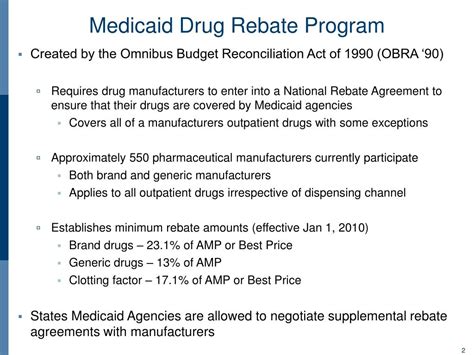Understanding the Medicaid Drug Rebate Program: What It Means for Patients and Pharmacies
The Medicaid Drug Rebate Program (MDRP) plays a crucial role in the healthcare landscape of the United States. Established in the Omnibus Budget Reconciliation Act of 1990, this program mandates that drug manufacturers provide rebates to state Medicaid programs for medications dispensed to eligible Medicaid beneficiaries. This article explores the intricacies of the MDRP, its significance for patients and pharmacies, and its implications in the broader context of healthcare access and affordability.
How the Medicaid Drug Rebate Program Works
The MDRP encompasses a partnership between state and federal governments, Medicaid recipients, and pharmaceutical manufacturers. Under this system, manufacturers are required to participate in the program to ensure that their drugs can be included in Medicaid formularies. For each covered drug, they must offer a rebate that is calculated based on a percentage of the Average Manufacturer Price (AMP) for the drug. This system effectively helps to lower the cost of medications for patients enrolled in Medicaid.
The rebates are critical as they return significant funds to state Medicaid programs, which can then be used to expand and improve healthcare services for enrolled patients. This dynamic not only promotes affordability but also incentivizes pharmaceuticals to keep their prices competitive in the marketplace.
The Impact on Patients
For patients, the Medicaid Drug Rebate Program represents a vital source of affordable medications. Medicaid recipients often belong to low-income populations, making access to essential drugs uphill without price controls. The rebates help ensure that these individuals can obtain necessary medications without facing prohibitive costs.
Moreover, the program assists in mitigating overall healthcare spending in the United States. Lower drug costs can lead to decreased emergency room visits and hospitalizations, contributing to better health outcomes and long-term healthcare savings. For many patients, this could mean the difference between managing a chronic condition effectively or facing severe health complications due to unaffordable medication.
The Role of Pharmacies
Pharmacies serve as the frontline providers in delivering medications to Medicaid patients. The MDRP influences pharmacies in multiple ways. First, by requiring manufacturers to offer these rebates, it allows pharmacies to maintain more stable pricing when dispensing medications. This is crucial for pharmacies, especially small and independent ones, as they often operate on thin profit margins.
Moreover, pharmacies are required to have robust systems in place to track and manage medications covered under the MDRP. This involves maintaining accurate records of all drugs dispensed along with their associated rebates to ensure compliance with federal and state regulations. Failure to adhere to these requirements can lead to financial penalties or exclusion from the Medicaid program.
Challenges and Limitations
While the MDRP provides benefits, it also presents challenges. One significant hurdle is the complexity of the reimbursement process. Pharmacies often face delayed or reduced reimbursements from Medicaid due to complicated administrative requirements tied to drug rebate calculations.
Additionally, not all formulations of a drug are eligible for rebates, which can lead to confusion among patients and providers. Pharmacies must rigorously train their staff to understand the nuances of the MDRP and to guide patients appropriately regarding which medications are covered and the associated costs.
Recent Developments and Future Directions
Recent developments in federal policies and initiatives aim to strengthen the MDRP and enhance access to medications for patients. Various legislative proposals have sought to allow for increased transparency in drug pricing and rebates, aimed at reducing the overall cost burden on pharmacies and patients alike.
As healthcare continues to evolve, changes to the Medicaid Drug Rebate Program may emerge to meet shifting demands, moving towards a more patient-centered approach that prioritizes affordability and access to necessary medications.
Conclusion
The Medicaid Drug Rebate Program remains a key component of the U.S. healthcare system, ensuring medications are more accessible for millions of Americans. Its role in providing rebates from pharmaceutical companies directly impacts the affordability of drugs for Medicaid beneficiaries. While challenges persist in the form of complex regulations and reimbursement processes, the MDRP ultimately serves to improve health outcomes and promote the effective management of chronic diseases. Ongoing improvements to the program will be essential to ensure that it continues to fulfill its intended goals and supports both patients and pharmacies in the ever-evolving healthcare landscape.
FAQs
What is the purpose of the Medicaid Drug Rebate Program?
The MDRP aims to provide affordable access to medications for Medicaid recipients by requiring drug manufacturers to offer rebates to state Medicaid programs, reducing medication costs for patients.
Who benefits from the Medicaid Drug Rebate Program?
Primarily, Medicaid beneficiaries benefit from the MDRP as it helps lower the costs of essential medications. Pharmacies also benefit through more stable pricing and reduced financial burden.
Are all medications covered under the Medicaid Drug Rebate Program?
No, not all medications are eligible. Certain formulations or new drugs may not have established rebates, which can complicate access for patients.
How do pharmacies manage compliance with the MDRP?
Pharmacies must maintain accurate records of all dispensed drugs and their corresponding rebates, implement effective tracking systems, and educate their staff on MDRP compliance requirements.
What recent changes have been proposed for the Medicaid Drug Rebate Program?
Proposals have emerged focusing on increasing transparency in drug pricing and enhancing access to medications for Medicaid patients, though specific details and implementations may vary over time.
Download Medicaid Drug Rebate Program
